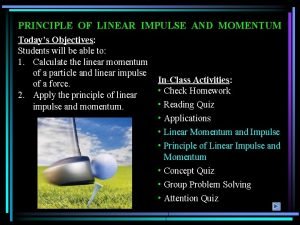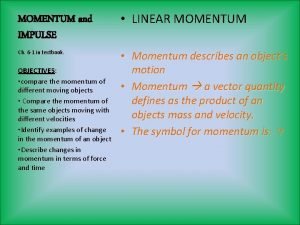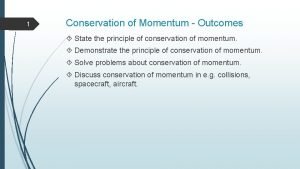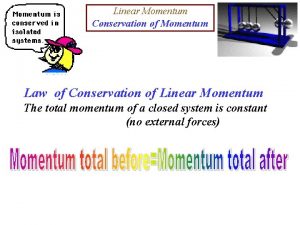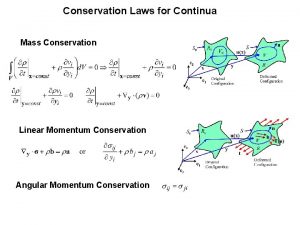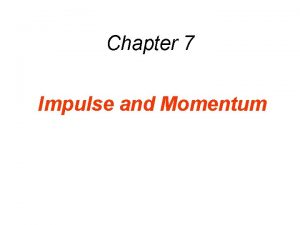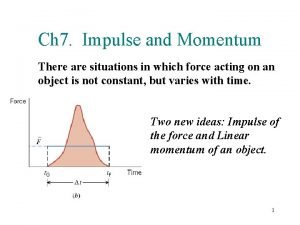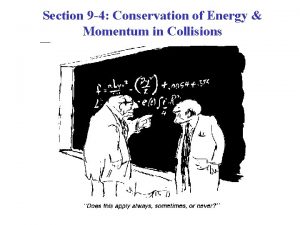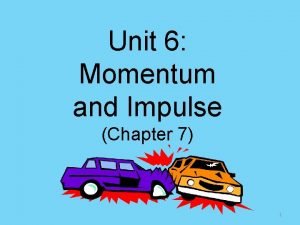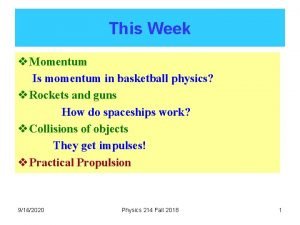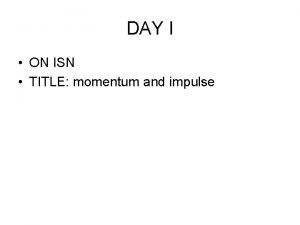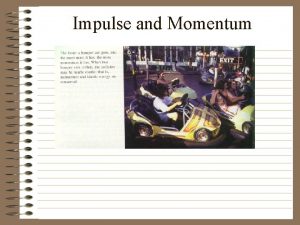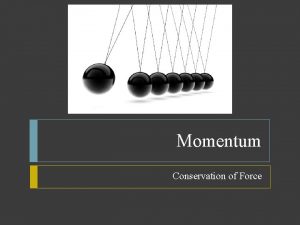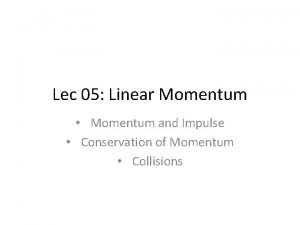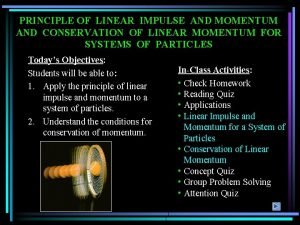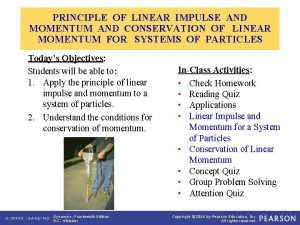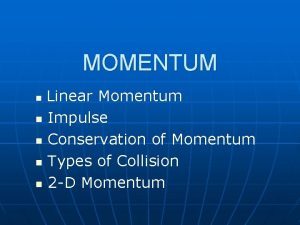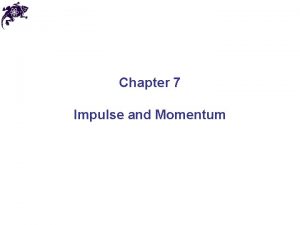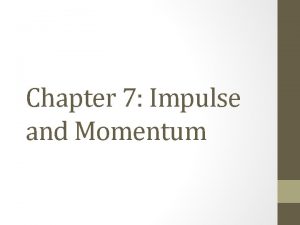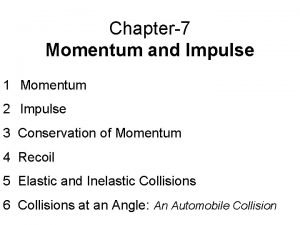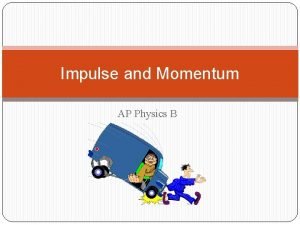PRINCIPLE OF LINEAR IMPULSE AND MOMENTUM AND CONSERVATION




















- Slides: 20

PRINCIPLE OF LINEAR IMPULSE AND MOMENTUM AND CONSERVATION OF LINEAR MOMENTUM FOR SYSTEMS OF PARTICLES Today’s Objectives: Students will be able to: 1. Apply the principle of linear impulse and momentum to a system of particles. 2. Understand the conditions for conservation of momentum. Dynamics, Fourteenth Edition R. C. Hibbeler In-Class Activities: • Check Homework • Reading Quiz • Applications • Linear Impulse and Momentum for a System of Particles • Conservation of Linear Momentum • Concept Quiz • Group Problem Solving • Attention Quiz Copyright © 2016 by Pearson Education, Inc. All rights reserved.

READING QUIZ 1. The internal impulses acting on a system of particles always _____ A) equal the external impulses. B) sum to zero. C) equal the impulse of weight. D) None of the above. 2. If an impulse-momentum analysis is considered during the very short time of interaction, as shown in the picture, weight is a/an _____ A) impulsive force. B) explosive force. C) non-impulsive force. D) internal force. Dynamics, Fourteenth Edition R. C. Hibbeler Copyright © 2016 by Pearson Education, Inc. All rights reserved.

APPLICATIONS As the wheels of this pitching machine rotate, they apply frictional impulses to the ball, thereby giving it linear momentum in the direction of Fdt and F’dt. The weight impulse, W t is very small since the time the ball is in contact with the wheels is very small. Does the release velocity of the ball depend on the mass of the ball? Dynamics, Fourteenth Edition R. C. Hibbeler Copyright © 2016 by Pearson Education, Inc. All rights reserved.

APPLICATIONS (continued) This large crane-mounted hammer is used to drive piles into the ground. Conservation of momentum can be used to find the velocity of the pile just after impact, assuming the hammer does not rebound off the pile. If the hammer rebounds, does the pile velocity change from the case when the hammer doesn’t rebound? Why? In the impulse-momentum analysis, do we have to consider the impulses of the weights of the hammer and pile and the resistance force? Why or why not? Dynamics, Fourteenth Edition R. C. Hibbeler Copyright © 2016 by Pearson Education, Inc. All rights reserved.

PRINCIPLE OF LINEAR IMPULSE AND MOMENTUM FOR A SYSTEM OF PARTICLES (Section 15. 2) For the system of particles shown, the internal forces fi between particles always occur in pairs with equal magnitude and opposite directions. Thus the internal impulses sum to zero. The linear impulse and momentum equation for this system only includes the impulse of external forces. t 2 å mi(vi)1 + å ò Fi dt = å mi(vi)2 t 1 Dynamics, Fourteenth Edition R. C. Hibbeler Copyright © 2016 by Pearson Education, Inc. All rights reserved.

MOTION OF THE CENTER OF MASS For a system of particles, we can define a “fictitious” center of mass of an aggregate particle of mass mtot, where mtot is the sum (å mi) of all the particles. This system of particles then has an aggregate velocity of v. G = (å mivi) / mtot. The motion of this fictitious mass is based on motion of the center of mass for the system. The position vector r. G = (å miri) / mtot describes the motion of the center of mass. Dynamics, Fourteenth Edition R. C. Hibbeler Copyright © 2016 by Pearson Education, Inc. All rights reserved.

CONSERVATION OF LINEAR MOMENTUM FOR A SYSTEM OF PARTICLES (Section 15. 3) When the sum of external impulses acting on a system of objects is zero, the linear impulse-momentum equation simplifies to å mi(vi)1 = å mi(vi)2 This equation is referred to as the conservation of linear momentum. Conservation of linear momentum is often applied when particles collide or interact. When particles impact, only impulsive forces cause a change of linear momentum. The sledgehammer applies an impulsive force to the stake. The weight of the stake is considered negligible, or non-impulsive, as compared to the force of the sledgehammer. Also, provided the stake is driven into soft ground with little resistance, the impulse of the ground acting on the stake is considered non-impulsive. Dynamics, Fourteenth Edition R. C. Hibbeler Copyright © 2016 by Pearson Education, Inc. All rights reserved.

EXAMPLE I Given: Spring constant k = 10 k. N/m m. A = 15 kg, v. A = 0 m/s, m. B = 10 kg, v. B = 15 m/s The blocks couple together at impact. Find: The maximum compression of the spring. Plan: 1) We can consider both blocks as a single system and apply the conservation of linear momentum to find the velocity after impact, but before the spring compresses. 2) Then use the energy conservation to find the compression of the spring. Dynamics, Fourteenth Edition R. C. Hibbeler Copyright © 2016 by Pearson Education, Inc. All rights reserved.

EXAMPLE I (continued) Solution: 1) Conservation of linear momentum + å mi(vi)0 = å mi(vi)1 10 ( 15 i) = (15+10) (v i ) v = 6 m/s 2) Energy conservation equation T 1 + V 1 = T 2 + V 2 0. 5 (15+10) (-6)2 + 0 = 0 + 0. 5 (10000) (smax) 2 So the maximum compression of the spring is smax = 0. 3 m. Dynamics, Fourteenth Edition R. C. Hibbeler Copyright © 2016 by Pearson Education, Inc. All rights reserved.

EXAMPLE II Given: Two rail cars with masses of m. A = 20 Mg and m. B = 15 Mg and velocities as shown. Find: The speed of the car A after collision if the cars collide and rebound such that B moves to the right with a speed of 2 m/s. Also find the average impulsive force between the cars if the collision place in 0. 5 s. Plan: Use conservation of linear momentum to find the velocity of the car A after collision (all internal impulses cancel). Then use the principle of impulse and momentum to find the impulsive force by looking at only one car. Dynamics, Fourteenth Edition R. C. Hibbeler Copyright © 2016 by Pearson Education, Inc. All rights reserved.

EXAMPLE II (continued) Solution: Conservation of linear momentum (x-dir): m. A(v. A 1) + m. B(v. B 1) = m. A(v. A 2)+ m. B(v. B 2) 20, 000 (3) + 15, 000 (-1. 5) = (20, 000) v. A 2 + 15, 000 (2) v. A 2 = 0. 375 m/s Impulse and momentum on car A (x-dir): m. A (v. A 1)+ ∫ F dt = m. A (v. A 2) 20, 000 (3) ∫ F dt = 20, 000 (0. 375) The average force is ∫ F dt = 52, 500 N·s = Favg(0. 5 sec); Favg = 105 k. N Dynamics, Fourteenth Edition R. C. Hibbeler Copyright © 2016 by Pearson Education, Inc. All rights reserved.

CONCEPT QUIZ 1) Over the short time span of a tennis ball hitting the racket during a player’s serve, the ball’s weight can be considered _______ A) nonimpulsive. B) impulsive. C) not subject to Newton’s second law. D) Both A and C. 2) A drill rod is used with a air hammer for making holes in hard rock so explosives can be placed in them. How many impulsive forces act on the drill rod during the drilling? A) None B) One C) Two D) Three Dynamics, Fourteenth Edition R. C. Hibbeler Copyright © 2016 by Pearson Education, Inc. All rights reserved.

GROUP PROBLEM SOLVING I Given: The free-rolling ramp has a mass of 40 kg. The 10 kg crate slides from rest at A, 3. 5 m down the ramp to B. Assume that the ramp is smooth, and neglect the mass of the wheels. Find: The ramp’s speed when the crate reaches B. Plan: Use the energy conservation equation as well as conservation of linear momentum and the relative velocity equation (you really thought you could safely forget it? ) to find the velocity of the ramp. Dynamics, Fourteenth Edition R. C. Hibbeler Copyright © 2016 by Pearson Education, Inc. All rights reserved.

GROUP PROBLEM SOLVING I (continued) Solution: vr v. C To find the relations between v. C and vr, use conservation of linear momentum: + 0 = (40) (−v ) + (10) v r Cx v. Cx = 4 vr (1) Since v. C = vr + v. C/r v. Cx i − v. Cy j = − vr i + v. C/r (cos 30 i − sin 30 j) v. Cx = − vr + v. C/r cos 30 (2) v. Cy = v. C/r sin 30 (3) Eliminating v. C/r from Eqs. (2) and (3), and substituting Eq. (1) results in v. Cy = 8. 660 vr Dynamics, Fourteenth Edition R. C. Hibbeler Copyright © 2016 by Pearson Education, Inc. All rights reserved.

GROUP PROBLEM SOLVING I (continued) Then, energy conservation equation can be written ; T 1 + V 1 = T 2 + V 2 0 + 10 (9. 81) (3. 5 sin 30) = 0. 5 (10) (v. C)2 + 0. 5 (40) (vr)2 0 + 10 (9. 81) (3. 5 sin 30) = 0. 5 (10) [ (v. Cx)2 + (v. Cy)2 ] + 0. 5 (40) (vr)2 = 0. 5 (10) [ (4. 0 vr)2 + (8. 660 vr)2 ] + 0. 5 (40) (vr)2 171. 7 = 475. 0 (vr)2 vr = 0. 601 m/s Dynamics, Fourteenth Edition R. C. Hibbeler Copyright © 2016 by Pearson Education, Inc. All rights reserved.

GROUP PROBLEM SOLVING II Given: Two rail cars with masses of m. A = 30 Mg and m. B = 15 Mg and velocities as shown. Find: The maximum compression of the spring mounted on car A. Plan: Use conservation of linear momentum to find the velocity of the cars after collision. Then use the energy conservation equation to find the compression of the spring. Dynamics, Fourteenth Edition R. C. Hibbeler Copyright © 2016 by Pearson Education, Inc. All rights reserved.

GROUP PROBLEM SOLVING II (continued) Solution: v 2 Conservation of linear momentum along x-axis: m. A(v. A 1) + m. B(v. B 1) = ( m. A + m. B ) v 2 where v. A 1 = 20 km/h = 5. 556 m/s, v. B 1 = -10 km/h = -2. 778 m/s 30, 000 (5. 556) + 15, 000 (-2. 778) = (30, 000 + 15000 ) v 2 = 2. 778 m/s Dynamics, Fourteenth Edition R. C. Hibbeler Copyright © 2016 by Pearson Education, Inc. All rights reserved.

GROUP PROBLEM SOLVING II (continued) Then, energy conservation equation to find the maximum compression of the spring ; T 1 + V 1 = T 2 + V 2 [0. 5 (30000) (5. 556)2 + 0. 5 (15000) (-2. 778)2 ] + 0 = 0. 5 (45000) (2. 778)2 + 0. 5 (3× 106) (smax)2 The maximum compression of the spring: smax = 0. 4811 m = 481 mm Dynamics, Fourteenth Edition R. C. Hibbeler Copyright © 2016 by Pearson Education, Inc. All rights reserved.

ATTENTION QUIZ 1. The 20 g bullet is fired horizontally at 1200 m/s into the 300 g block resting on a smooth surface. If the bullet becomes embedded in the block, what is the velocity of the block immediately after impact. 1200 m/s A) 1125 m/s B) 80 m/s C) 1200 m/s D) 75 m/s 2. The 200 -g baseball has a horizontal velocity of 30 m/s when it is struck by the bat, B, weighing 900 -g, moving at 47 m/s. During the impact with the bat, how many impulses of importance are used to find the final velocity of the ball? vball A) Zero B) One BAT C) Two D) Three Dynamics, Fourteenth Edition R. C. Hibbeler vbat Copyright © 2016 by Pearson Education, Inc. All rights reserved.

Dynamics, Fourteenth Edition R. C. Hibbeler Copyright © 2016 by Pearson Education, Inc. All rights reserved.
 Linear impulse momentum equation
Linear impulse momentum equation Linear impulse equation
Linear impulse equation Principle of angular impulse and momentum
Principle of angular impulse and momentum A 2250 kg car traveling to the west slows down
A 2250 kg car traveling to the west slows down What is the change in momentum
What is the change in momentum State the principle of conservation of momentum
State the principle of conservation of momentum Law of conservation of linear momentum
Law of conservation of linear momentum Conservation of linear momentum
Conservation of linear momentum Impulse momentum theorem definition
Impulse momentum theorem definition Conservation of linear momentum
Conservation of linear momentum Conservation of linear momentum
Conservation of linear momentum Conversion of linear momentum
Conversion of linear momentum Granny whizzes around the rink and is suddenly
Granny whizzes around the rink and is suddenly Physics 03-02 potential energy and conservative forces
Physics 03-02 potential energy and conservative forces Unit 6 momentum and impulse
Unit 6 momentum and impulse Unit of momentum and impulse
Unit of momentum and impulse Basketball impulse and momentum
Basketball impulse and momentum Importance of momentum and impulse
Importance of momentum and impulse Poem about impulse and momentum
Poem about impulse and momentum Importance of momentum and impulse
Importance of momentum and impulse Impulse momentum
Impulse momentum
